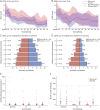Phase 2 Trial of Rituximab in Acetylcholine Receptor Antibody-Positive Generalized Myasthenia Gravis: The BeatMG Study
- PMID: 34857535
- PMCID: PMC8793103
- DOI: 10.1212/WNL.0000000000013121
Phase 2 Trial of Rituximab in Acetylcholine Receptor Antibody-Positive Generalized Myasthenia Gravis: The BeatMG Study
Abstract
Objective: To determine whether rituximab is safe and potentially beneficial, warranting further investigation in an efficacy trial for acetylcholine receptor antibody-positive generalized MG (AChR-Ab+ gMG).
Methods:
The B-Cell Targeted Treatment in MG (BeatMG) study was a randomized, double-blind, placebo-controlled, multicenter phase-2 trial that utilized a futility design. Individuals 21-90 years of age, with AChR-Ab+ gMG (MG Foundation of America Class II-IV) and receiving prednisone ≥15 mg/day were eligible. The primary outcome was a measure of steroid-sparing effect, defined as the proportion achieving ≥75% reduction in mean daily prednisone dose in the 4-weeks prior to week 52
Results: Of the 52 participants included, mean (±SD) age at enrollment was 55.1 (±17.1) years; 23 (44.2%) were female, and 31 (59.6%) were MGFA Class II. The mean (±SD) baseline prednisone dose was 22.1 (±9.7) mg/day. The primary steroid-sparing outcome was achieved in 60% of those on rituximab vs. 56% on placebo. The study reached its futility endpoint (p=0.03) suggesting that the pre-defined clinically meaningful improvement of 30% due to rituximab over placebo was unlikely to be achieved in a subsequent, larger trial. No safety issues identified.
Conclusions: While rituximab was safe and well-tolerated, these results suggest that there is a low probability of observing the defined clinically meaningful steroid-sparing effect over a 12-month period in a phase-3 trial of mild-moderately symptomatic AChR-Ab+ gMG.
Classification of evidence: This study provides Class I evidence that for mild-to-moderate AChR-Ab+ gMG, compared with placebo, rituximab is safe but unlikely to reduce steroid use by an absolute difference of at least 30% at 1 year.
Trial registration: ClinicalTrials.gov Identifier: NCT02110706.
© 2021 American Academy of Neurology.
Figures



Similar articles
-
Efficacy and safety of rozanolixizumab in patients with muscle-specific tyrosine kinase autoantibody-positive generalised myasthenia gravis: a subgroup analysis of the randomised, double-blind, placebo-controlled, adaptive phase III MycarinG study.Ther Adv Neurol Disord. 2024 Sep 12;17:17562864241273036. doi: 10.1177/17562864241273036. eCollection 2024. Ther Adv Neurol Disord. 2024. PMID: 39297052 Free PMC article.
-
Clinical Effects of the Self-administered Subcutaneous Complement Inhibitor Zilucoplan in Patients With Moderate to Severe Generalized Myasthenia Gravis: Results of a Phase 2 Randomized, Double-Blind, Placebo-Controlled, Multicenter Clinical Trial.JAMA Neurol. 2020 May 1;77(5):582-592. doi: 10.1001/jamaneurol.2019.5125. JAMA Neurol. 2020. PMID: 32065623 Free PMC article. Clinical Trial.
-
Safety and efficacy of eculizumab in anti-acetylcholine receptor antibody-positive refractory generalised myasthenia gravis (REGAIN): a phase 3, randomised, double-blind, placebo-controlled, multicentre study.Lancet Neurol. 2017 Dec;16(12):976-986. doi: 10.1016/S1474-4422(17)30369-1. Epub 2017 Oct 20. Lancet Neurol. 2017. PMID: 29066163 Clinical Trial.
-
Ravulizumab: A Review in Generalised Myasthenia Gravis.Drugs. 2023 Jun;83(8):717-723. doi: 10.1007/s40265-023-01877-6. Epub 2023 May 11. Drugs. 2023. PMID: 37166620 Review.
-
Ravulizumab (Ultomiris): CADTH Reimbursement Recommendation: Indication: For the treatment of adult patients with anti-acetylcholine receptor antibody–positive generalized myasthenia gravis [Internet].Ottawa (ON): Canadian Agency for Drugs and Technologies in Health; 2023 Aug. Report No.: SR0765. Ottawa (ON): Canadian Agency for Drugs and Technologies in Health; 2023 Aug. Report No.: SR0765. PMID: 38085842 Free Books & Documents. Review.
Cited by
-
Knowledge mapping of targeted immunotherapy for myasthenia gravis from 1998 to 2022: A bibliometric analysis.Front Immunol. 2022 Sep 29;13:998217. doi: 10.3389/fimmu.2022.998217. eCollection 2022. Front Immunol. 2022. PMID: 36248874 Free PMC article.
-
Novel pathophysiological insights in autoimmune myasthenia gravis.Curr Opin Neurol. 2022 Oct 1;35(5):586-596. doi: 10.1097/WCO.0000000000001088. Epub 2022 Aug 4. Curr Opin Neurol. 2022. PMID: 35942663 Free PMC article. Review.
-
Clinical Outcomes in AchR Antibody-Positive Myasthenia Gravis: Where Does Rituximab Stand in the Current Times?Ann Indian Acad Neurol. 2023 Jul-Aug;26(4):313-314. doi: 10.4103/aian.aian_516_23. Epub 2023 Aug 25. Ann Indian Acad Neurol. 2023. PMID: 37970317 Free PMC article. No abstract available.
-
New Targeted Agents in Myasthenia Gravis and Future Therapeutic Strategies.J Clin Med. 2022 Oct 28;11(21):6394. doi: 10.3390/jcm11216394. J Clin Med. 2022. PMID: 36362622 Free PMC article. Review.
-
Corticosteroid Treatment-Resistance in Myasthenia Gravis.Front Neurol. 2022 Apr 25;13:886625. doi: 10.3389/fneur.2022.886625. eCollection 2022. Front Neurol. 2022. PMID: 35547366 Free PMC article. Review.
References
-
- Dalakas MC. Invited article: inhibition of B cell functions: implications for neurology. Neurology. 2008;70(23):2252-2260. - PubMed
-
- Lebrun C, Bourg V, Tieulie N, Thomas P. Successful treatment of refractory generalized myasthenia gravis with rituximab. Eur J Neurol. 2009;16(2):246-250. - PubMed
-
- Diaz-Manera J, Martinez-Hernandez E, Querol L, et al. . Long-lasting treatment effect of rituximab in MuSK myasthenia. Neurology. 2012;78(3):189-193. - PubMed
-
- Illa I, Diaz-Manera J, Rojas-Garcia R, et al. . Sustained response to Rituximab in anti-AChR and anti-MuSK positive Myasthenia Gravis patients. J Neuroimmunol. 2008;201-202:90-94. - PubMed
Associated data
Grants and funding
LinkOut - more resources
Full Text Sources
Medical
Research Materials
